Learning how to choose wall art is the key to elevating your home decor, allowing you to transform blank walls into beautiful, eye-catching focal points that perfectly encapsulate your style and personality. However, the process of selecting and arranging art can feel overwhelming if you don’t know where to start. Fortunately, with the right guidance, anyone can transform a room into a well-curated space that looks professionally styled. For this reason, this ultimate wall art guide will share 10 expert tips on how to decorate like a pro and make your walls a masterpiece.
Why Wall Art is a Crucial Element of Interior Design
Before we dive into the tips, it’s important to understand why art is so fundamental to great interior design. Wall art does much more than simply fill an empty space. A well-chosen piece can serve as the soul of a room—it sets the mood, introduces a color palette, and adds a layer of sophistication. It’s the finishing element that pulls a room together, making it feel complete and lived-in. In short, art is a powerful tool that infuses your home with personality and tells your unique story.
Defining Your Personal Art Style
The first step in how to choose wall art is to understand your own taste. You don’t need to be an art historian; you just need to know what you love. Consider the overall style of your home. Are you drawn to the simplicity of Minimalist wall art, the warmth of rustic decor, or the free-spirited nature of a bohemian aesthetic? Identifying your core style will help you narrow down your options and create a cohesive theme that flows throughout your home.
1. Start with a Plan and a Cohesive Theme
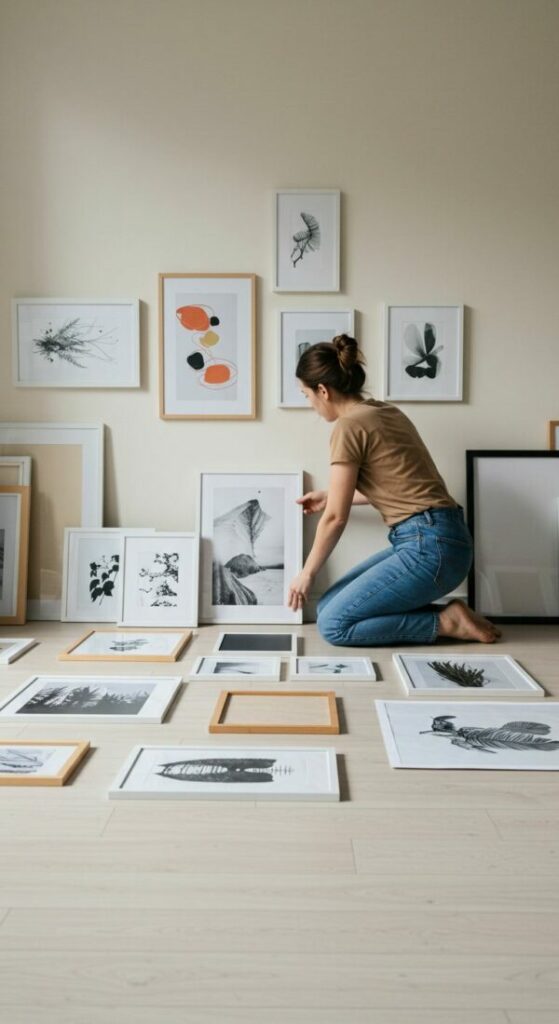
Spontaneity can be fun, but a strategic approach prevents a chaotic and disjointed result. A clear plan ensures every piece you choose has a purpose and contributes to a harmonious and cohesive design. This foundational step is what separates amateur decorating from a professional, curated look.
Before you buy anything, take a step back and assess your space. Measure the wall and consider the room’s scale. Decide on a cohesive theme or style—such as modern minimalist, rustic charm, or eclectic vibes. Then, decide on your color palette. Will the art complement the existing room colors, or will it introduce a bold new accent color? Creating a simple mood board can be incredibly helpful here.
Take a photo of your wall and use a simple photo-editing app on your phone or computer to digitally place potential art pieces onto the image. This allows you to visualize the final look and test different options without any commitment.
2. Choose the Right Size for Visual Balance
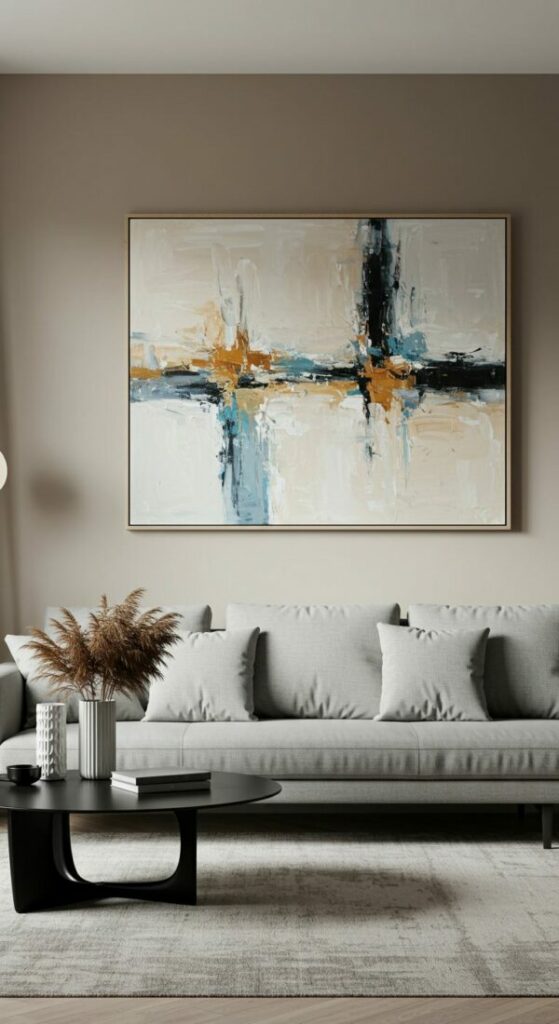
The principles of scale and proportion are critical in home decor. Art that is too small for a wall can look insignificant and lost, while art that is too large can overwhelm a room. Choosing the right size art is the key to achieving visual balance and making the composition feel harmonious and intentional.
For large, empty walls, select a single piece of large-scale art or a substantial gallery wall to make a statement. For smaller spaces, a more modest piece or a simple diptych (a set of two) can work beautifully. A crucial rule of thumb is to ensure your art is in proportion to nearby furniture. For instance, art hung above a sofa or bed should be approximately two-thirds the width of the furniture below it.
When in doubt, err on the side of slightly too big rather than too small. A larger piece of art almost always looks more intentional and high-end than a piece that is too small for its space. This is a core secret of decorating with wall art.
3. Mix and Match Art Styles for a Dynamic Look
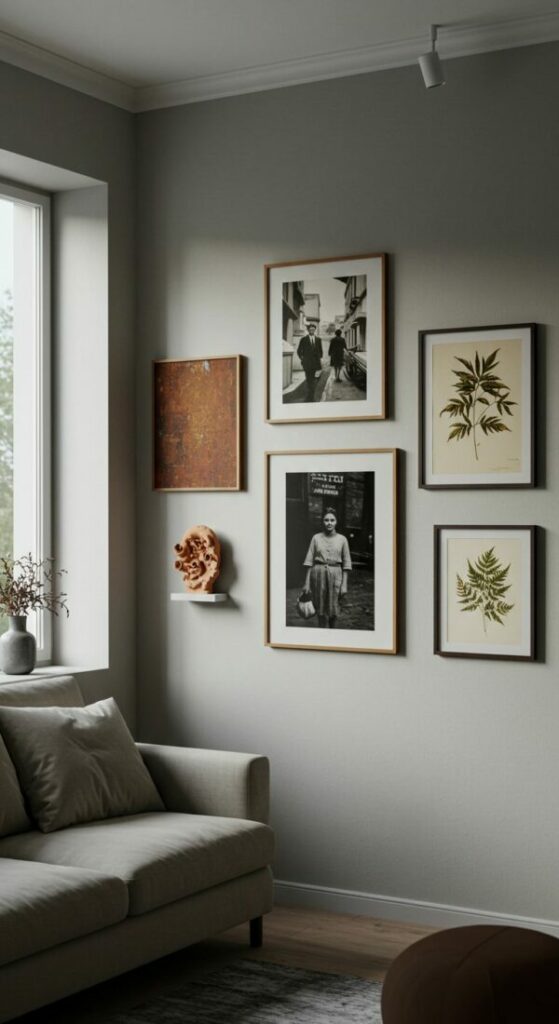
A wall filled with only one type of art can sometimes feel flat or one-dimensional. By mixing art styles, you create a space that is dynamic, interesting, and looks thoughtfully collected over time. This variety is your secret weapon for a sophisticated, curated look.
Don’t be afraid to combine different mediums. For example, layer paintings with photography and sculptural elements. Play with a variety of frame styles—mixing wood, metal, and acrylic frames will add rich texture. You can also blend genres, such as pairing a classic landscape with a modern piece of abstract art, or contemporary prints with vintage pieces for a truly unique collection.
To unify a very eclectic collection, find a common thread. This could be a consistent color that appears in each piece, or you could re-frame everything in the same style of frame to create a sense of cohesion among diverse artworks.
4. Create a Powerful Focal Point with Art
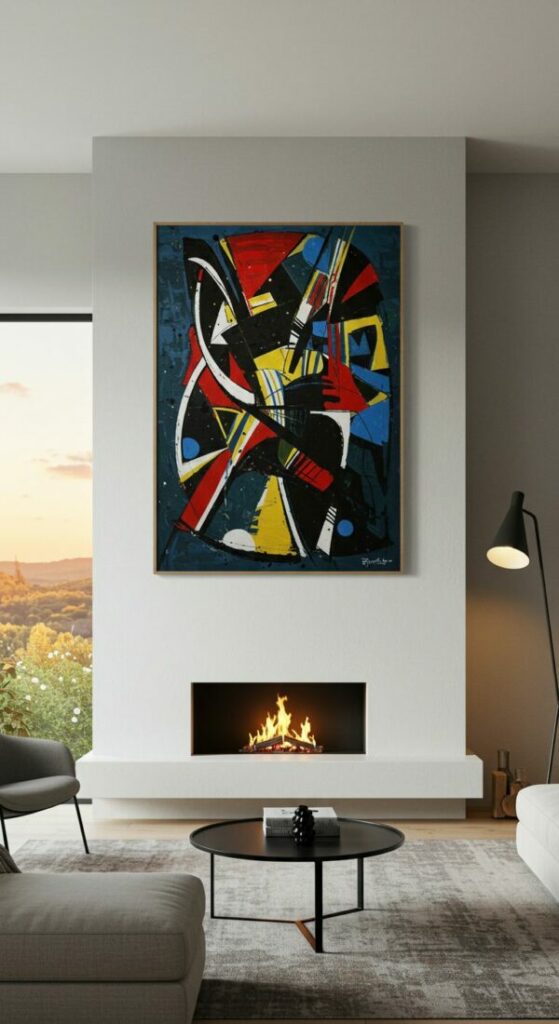
A focal point acts as the visual anchor of a room, immediately drawing the eye and giving the space a sense of purpose and order. Using a powerful piece of art as this anchor is an effective way to establish a clear hierarchy and prevent the room from feeling scattered.
The process of creating a focal point with art begins by selecting a bold statement piece—often an oversized or particularly compelling artwork. Proper placement is key. Hang your focal art above a significant piece of furniture, such as the sofa in the art for living room, the fireplace, or the headboard in a bedroom. To enhance the effect, you can surround this centerpiece with smaller, complementary pieces that don’t compete for attention.
The focal point doesn’t always have to be the largest piece. It can also be the most colorful or the most unusual piece in the room. Whatever commands attention first is your focal point, so place it wisely.
5. Experiment with Different Layouts and Arrangements
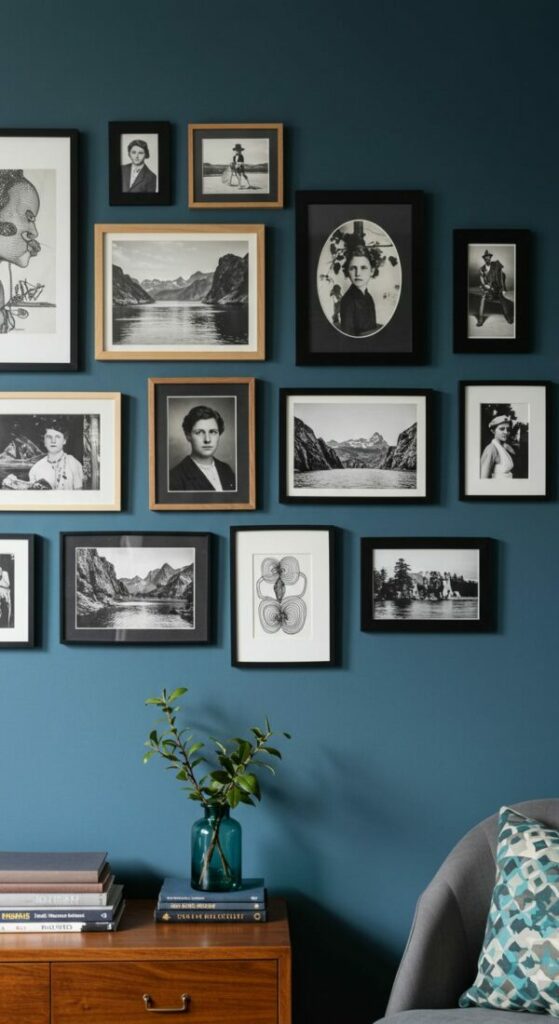
The way you go about arranging wall art has a direct impact on the atmosphere of the space. Different layouts can make a room feel formal and ordered, or relaxed and eclectic. Experimenting allows you to find a style that perfectly matches your desired mood.
For a formal and clean look, opt for symmetrical layouts, where art is hung with equal spacing and alignment, often in a grid. For a more relaxed and contemporary vibe, an asymmetrical layout or staggered arrangement is ideal. Gallery wall ideas are incredibly popular; you can arrange different pieces in an organized grid or a more organic cluster to create compelling visual interest.
When creating a gallery wall, a “salon-style” hang (a dense cluster of many different pieces) looks best when anchored by a large central piece. Start by hanging your biggest piece slightly off-center, then build the rest of your arrangement around it.
6. Embrace Color Psychology to Set the Mood
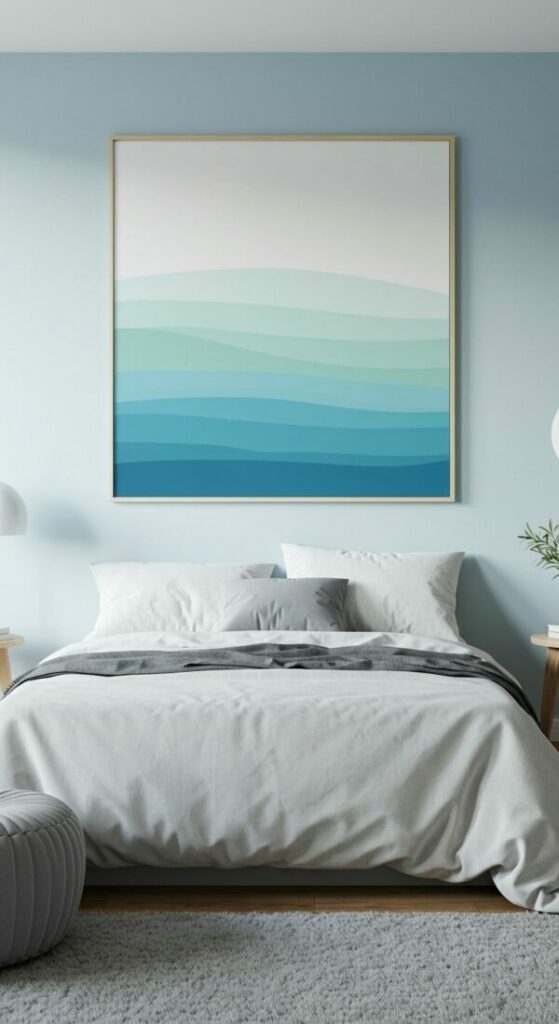
Colors have a profound psychological impact on our mood and emotions. Understanding color psychology in art allows you to be an emotional architect for your space, intentionally creating an atmosphere that is either energizing, calming, or sophisticated.
Choose art based on the atmosphere you want to create. For rooms where you want to feel energized and social, like a kitchen or dining room, choose art with warm tones like reds, oranges, and yellows. For spaces meant for relaxation, like a bedroom or bathroom, opt for cool tones like blues, greens, and purples, which have a calming effect. Also, sense of balance and sophistication, a color scheme based on neutral shades like blacks, whites, and grays is timeless.
You don’t have to choose just one. A piece of art that features a balanced mix of both warm and cool colors can create a dynamic yet harmonious feeling, making it versatile for almost any room.
7. Layer with Textures to Add Depth and Interest
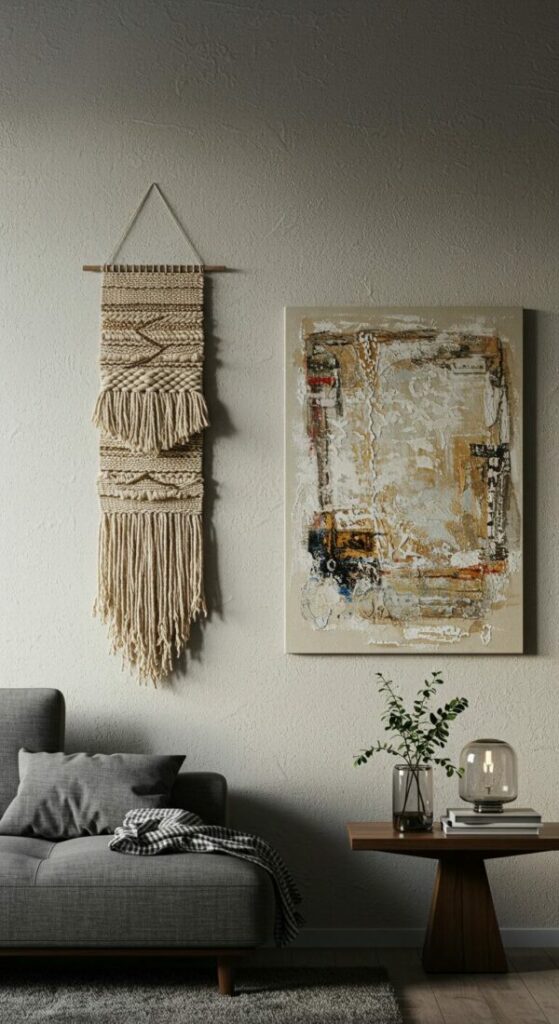
A room decorated with only flat surfaces can feel stark and uninviting. Adding textural elements gives your walls physical and visual depth, making the space feel richer, more complex, and more engaging to the senses. Texture is a key component of professional home decor.
Think beyond the standard print. Incorporate mixed-media pieces that combine paint with fabric or metal. Introduce 3D elements and sculptural elements, such as woven wall hangings, macrame, or wall-mounted planters. Even your framing choices can add texture; consider frames with rustic wood grain or an ornate carved design, and experiment with different matting options for an extra layer of detail.
One of the easiest ways to add texture is to hang a beautiful, shallow basket or a collection of them on the wall. This is an affordable and stylish way to bring a natural, bohemian element into your decor.
8. Consider the Impact of Lighting
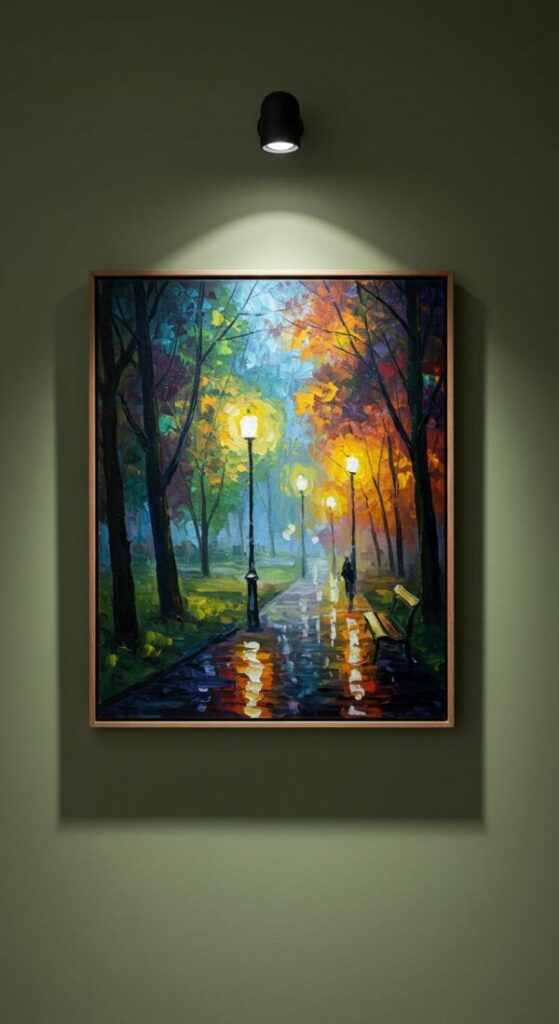
Proper lighting for wall art is like the final polish on a masterpiece. Good lighting makes colors appear more vibrant and details more crisp, ensuring your art looks its absolute best. It transforms your display from just “pictures on a wall” to a sophisticated, gallery-like installation.
Position your art to take advantage of natural light, but avoid hanging valuable pieces in direct, harsh sunlight, which can cause fading over time. For evening viewing and to highlight your favorite pieces, use accent lighting. This can be achieved with dedicated picture lights installed above the frame, adjustable track lighting, or even wall sconces placed on either side of an artwork. Installing dimmer controls will allow you to adjust the intensity to set the perfect mood.
For a modern and dramatic look, try backlighting your art. Placing LED strips around the back edge of a large canvas creates a soft, ambient glow that makes the artwork appear to float off the wall.
9. Personalize Your Selection to Tell Your Story
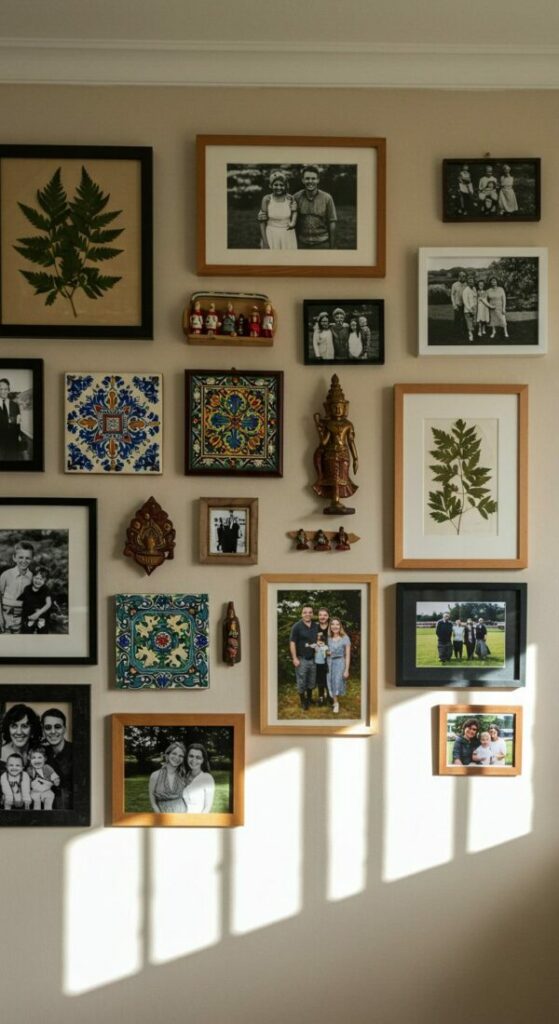
The most beautiful homes are those that feel authentic and personal. Personalizing your home with art that tells your story is the most effective way to create a space that is uniquely yours. It transforms your house into a home filled with meaning and cherished memories.
Think beyond store-bought prints. Create a gallery wall of your favorite family photos. Frame maps of cities you’ve visited or postcards you’ve collected as travel souvenirs. Display your children’s drawings in high-quality frames. If you’re crafty, create your own DIY projects, such as a pressed-flower frame or an abstract painting. This is the ultimate guide to making your space personal.
Elevate your personal photos by having them printed in a consistent style (e.g., all black and white) and matted and framed professionally. This simple step can make a collection of casual snapshots look like a high-end art installation.
10. Keep It Flexible for an Evolving Style
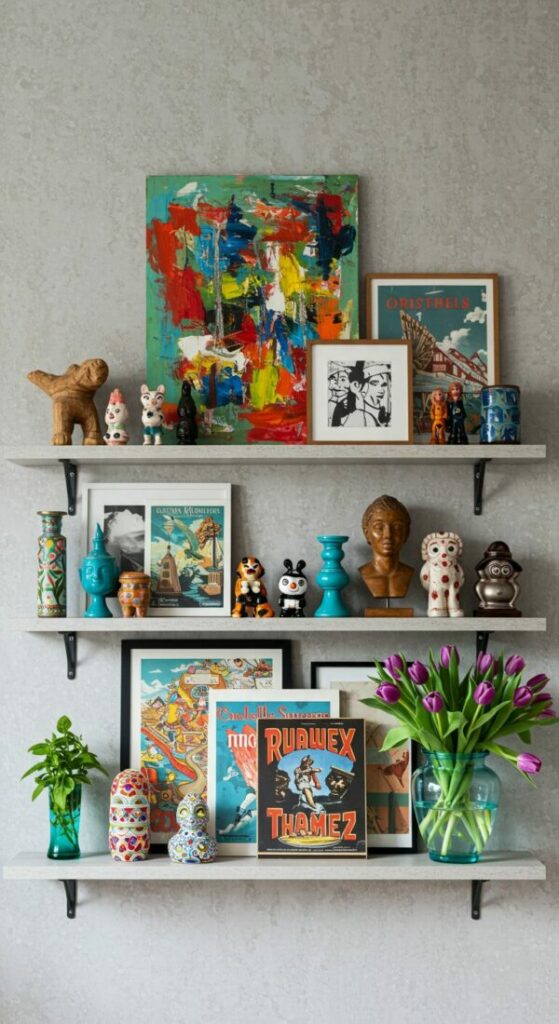
Your tastes and style will evolve over time. Planning for adaptability from the start means your wall decor ideas can grow with you. A flexible display prevents you from being locked into one look and saves your walls from countless nail holes.
Picture ledges and floating shelves are a designer’s best friend. They allow you to easily swap out framed art, decor, and books without any tools. For hanging directly on the wall, consider using removable mounting solutions like Command Strips for lighter pieces. This allows you to experiment with layouts commitment-free. A strategy of arranging wall art this way lets you refresh your walls seasonally or whenever you find a new piece you love.
A large, empty frame hung on the wall can be a piece of art in itself. You can use clips to hang smaller, unframed photos or prints inside it, and easily swap them out whenever you like for a constantly evolving display.
Common Mistakes to Avoid When Decorating with Wall Art
Even with the best intentions, a few common pitfalls can undermine your efforts. Being aware of them is half the battle. Avoid these mistakes to ensure your walls look polished:
- Hanging Art Too High: This is the most common mistake. It makes art feel disconnected from the room and its furniture. Always follow the eye-level rule (center of the art at 57-60 inches).
- Choosing Art That’s Too Small: A tiny print on a vast wall creates a feeling of emptiness. Remember to consider scale and proportion; it’s better to have one large piece than one that’s too small.
- Forgetting a Cohesive Theme: Without a unifying element (like a consistent color palette or frame style), a collection of art can look random and cluttered rather than curated.
- Ignoring Lighting: A beautiful piece of art left in a dark corner will never be fully appreciated. Good lighting for wall art is not an afterthought; it’s an essential part of the display.
Conclusion
You don’t need an interior design degree to decorate your walls like a pro — just a considered approach and some creative thinking. Choosing just the right size or large works of artwork , experimenting with layout and texture options. These tips will help you create a place that’s at once both visually striking and entirely personal.
You know what? Go on, get together your favorite pieces, get creative and create your personal masterpiece on your walls, reflecting your personal style.
Frequently Asked Questions (FAQ)
There are many fantastic places! Online marketplaces like Etsy offer unique prints from independent artists. Stores like HomeGoods and Target have stylish and budget-friendly options. You can also download high-resolution public domain images from museum websites for free and have them printed yourself for a very affordable piece of large-scale art.
For heavy pieces, it’s crucial not to rely on a single nail in drywall. You should always use a stud finder to locate a wall stud for maximum support. If a stud isn’t available in your desired location, use a heavy-duty wall anchor (like a toggle bolt or a screw-in anchor) rated for the weight of your art. This is a critical step in how to hang wall art safely.
Not at all! Mixing frame styles can create a more eclectic and collected look. The key to success is to have another unifying element. For example, you could mix different wood and metal frames, but ensure all the artwork is black and white. Or, you could have a wide variety of art, but have all the frames be black. This creates cohesion without being too uniform.
Yes, absolutely! This is a secret of professional interior designers. Mixing high and low is a great way to build a collection. A high-quality frame can make an inexpensive print look much more valuable. Placing a simple print next to an original painting can make the whole collection feel more approachable and authentic. It’s all about how you present the pieces together.
